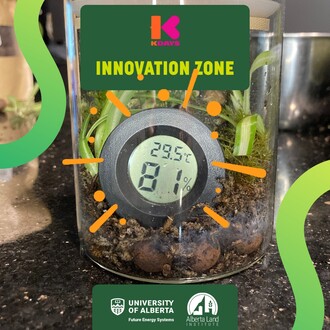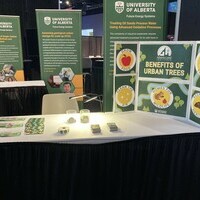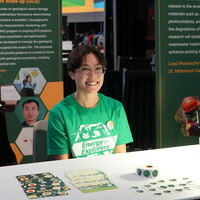K-Days Energy Innovation Zone with Future Energy Systems: Terrarium experiment unexpected findings

This past weekend, the Alberta Land Institute was with Future Energy Systems at the K-Days Energy Innovation Zone. The ALI table was run by ALI’s communications coordinator (myself) and Nilusha Weledegara, our research manager.
We were, once again, highlighting the ongoing research on the benefits of urban trees with a small sticker activity alongside a small demonstration.

We based our demo on research that has found plants and trees reduce temperatures and increase humidity, and that asphalt stores thermal radiation.
In fact, reforestation efforts in the Eastern US may be partially responsible for an area of cooler average temperatures, dubbed a “warming hole.”
The demo consisted of two glass containers, each with a thermometer/hygrometer to measure temperature and humidity. In one glass container was a piece of asphalt, while the other was transformed into a terrarium containing soil, live plants and moss.
Based on the research, we predicted that the asphalt container would be hotter and drier than the terrarium however, there were some unexpected initial results.

As you can see, after sitting the sun with the lids on, the containers were a staggering 45 degrees celsius!! Even after removing the containers from the sun, the terrarium remained slightly hotter than the asphalt container.
After consulting Nilusha, she recommended removing the lids. Nilusha suggested that the temperature in the terrarium may be due to water stress, which can cause plant temperature to increase.
Studies have also shown that high temperatures also cause plants to respire more which can increase temperature, which may have also been the problem.
Whatever the case, removing the lids did the trick!
During K-Days, we kept the lids off of the containers and used a plant light to simulate sunlight. Throughout the day, both containers warmed up but, as predicted, the terrarium remained cooler and more humid.
You may be wondering, like I was, how might plant respiration in response to heat affect global temperatures as the earth’s temperatures rise?
Studies suggest that while hotter temperatures initially lead to increased respiration from plants, respiration eventually decreased again, potentially as a result of the plants adapting.
An article published in Pennstate Extension by Arborist Julianne Schieffer outlines some suggestions for how to reduce heat stress on trees. Some suggestions include:
- providing shade for trees through companion vegetation or structures
- covering the surface with organic material to minimize water loss
- watering, sprinkling, or misting to reduce temperature and keep our trees water-efficient
You can read more about Schieffer’s suggestions here.
Overall, the event was a success, and I unexpectedly ended up learning about heat stress in plants!
Thank you to everyone who visited the Energy Innovation Zone, and thank you to Future Energy Systems for inviting us to participate!
Christopher Chan’s research “The Role of Urban Forests in Community Adaptation and Resilience,” is ongoing but will discuss whether current land use policies effectively capture the full value of the ecosystem services urban trees provide. Keep an eye on our research page or updates!




